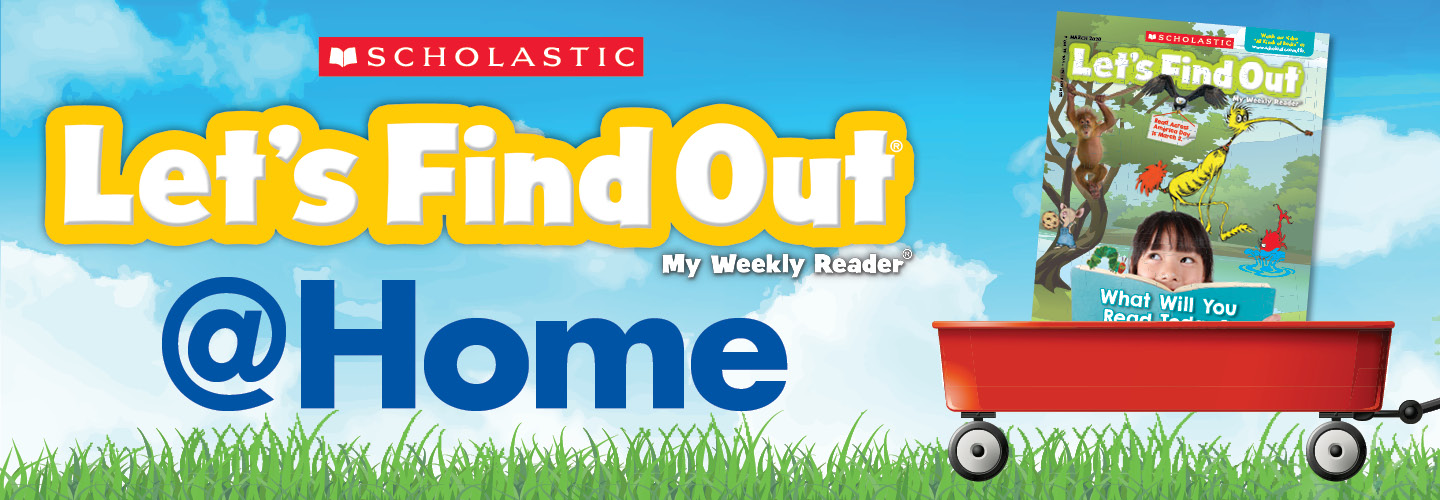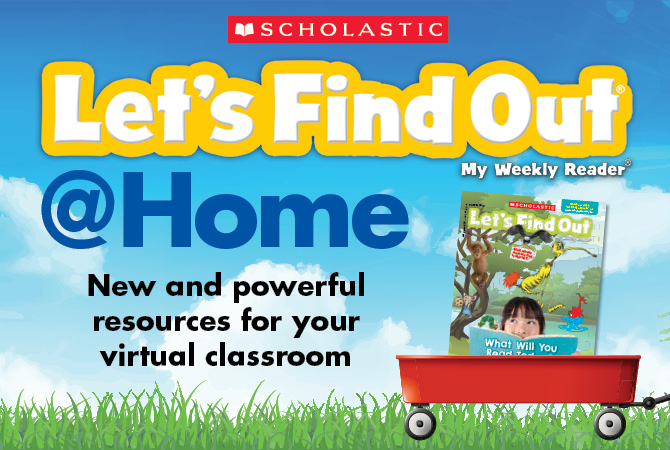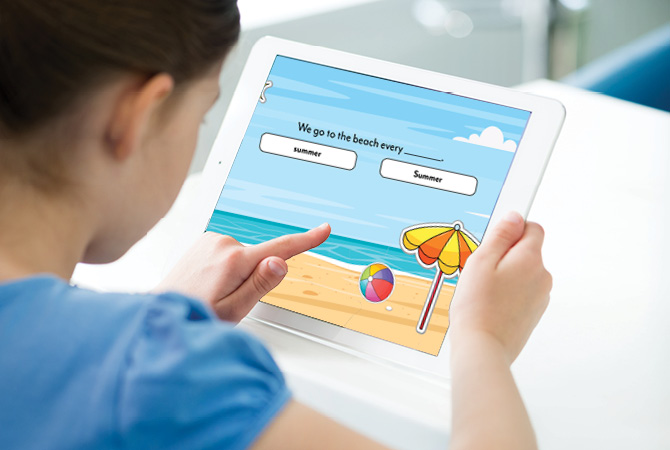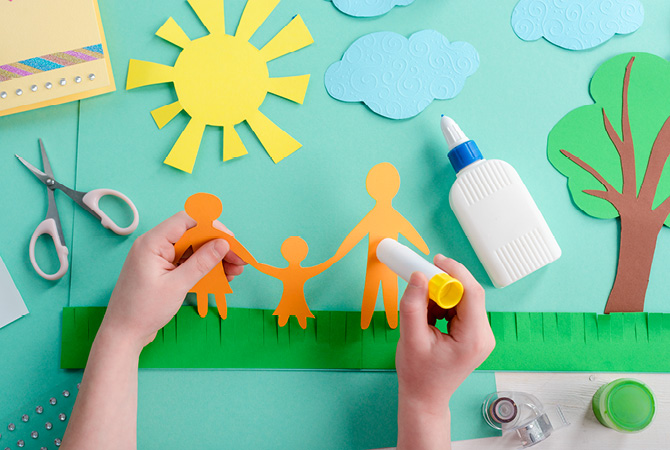Movement and Games
1. Balloon Keep-Up
This activity has movement and math.
Materials: a balloon
Challenge your child to keep a balloon from falling to the floor without catching or holding it! Add in some counting practice. How many times can they hit it up before it falls?
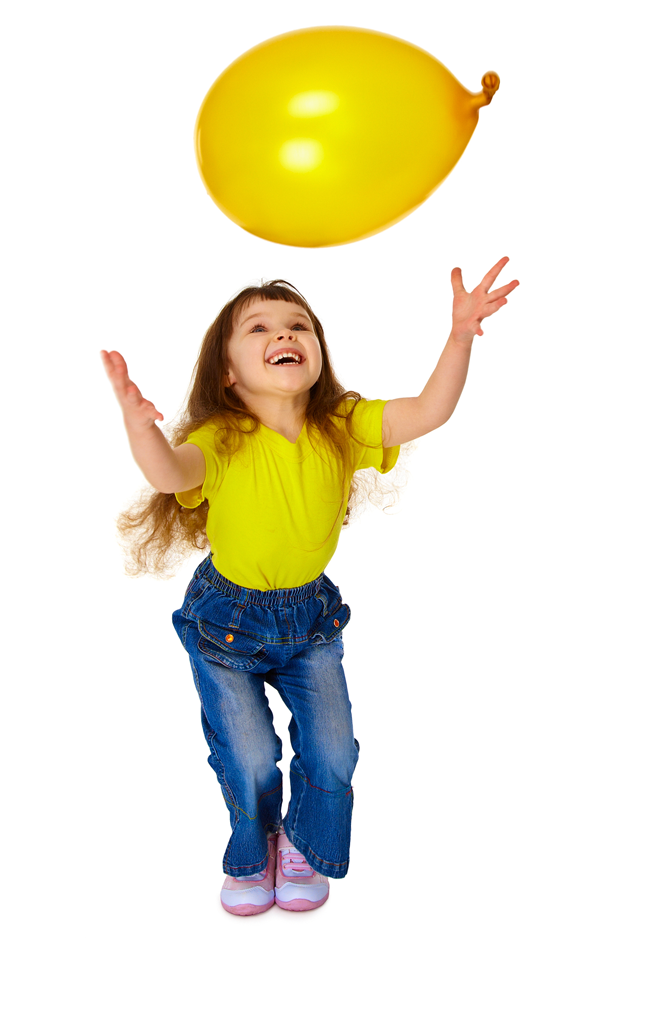
2. Classic Game of Hot/Cold
This activity builds vocabulary.
Materials: an item to hide
Remember this game? Hide an item (toy, hat, anything) in the room. Have your child wander around looking for the item. If they are moving away from the item, say they are getting colder . . . icy . . . freezing cold! If they are moving closer, say they are getting warmer, hot, boiling hot! Have fun building vocabulary by using different words for hot and cold.
3. Look for Letters!
This activity builds early reading skills.
Materials: any items in the kitchen
Do an alphabet scavenger hunt in the kitchen! Give your child a letter to look for on boxes, canned goods, jars—anything with a label. Make it an ongoing challenge by starting with A and going in alphabetical order. Can you find every letter in the alphabet?
4. Indoor Obstacle Course
This activity gets your child moving!
Materials: items from around the house, such as pillows, tape, balls, a broom, tissues, chairs, a stopwatch, etc.
Create some space for the obstacle course. Set up some obstacles, like pillows to climb over or a broom set across two chairs to crawl under. Have your child move from obstacle to obstacle doing different movements—slithering like a snake, carrying a cotton ball on a spoon, bouncing a ball, or crab walking. You can also create mini-challenges, like jumping over a piece of tape five times or singing “Twinkle Twinkle Little Star” while they stick out their tongue. When you’re done setting up, have your child do the obstacle course. Time them as they go. Then challenge them to do it again to try and beat their previous time!
5. Color and Shape Search
This activity helps your child work on counting, shapes, and colors.
Materials: none
Go on a walk with your child. While you’re walking, give them a challenge of things to find by picking a number and a category. For example, ask your child to find five green things or seven squares. Then work together to find them! You could also do this activity inside your home.
6. Indoor Bowling
This activity builds math skills and hand-eye coordination.
Materials: plastic cups, empty cans or plastic bottles, ball
Make your own indoor bowling alley! Set up 10 plastic cups, empty cans, or empty plastic bottles as pins. Then create a starting line, and let your child “bowl” using a ball. While they are playing, ask how many pins fell down each time. How many are left?
7. Freeze Dance
This activity fosters coordination and motor skills.
Materials: music, space (indoor or outdoor)
Play your child’s favorite song. Have them dance while the music plays. Stop the music every 15 to 30 seconds and then freeze in place whenever it stops! Keep going until the song ends.

8. Mirror, Mirror
This activity improves concentration.
Materials: none
Have your child stand face-to-face with someone else.
Choose who will be Person A and who will be Person B. Person A will be the “mover” first. Person A will start out with small movements, like wiggling their nose. Then they should try bigger movements, like swinging an arm from side to side. Person B must follow Person A’s movements EXACTLY. It should look like Person A is looking in a mirror!
Then switch! Person B will be the “mover.” Person A will follow their every move.
Science and Nature
1. Squirrel Safari
This activity encourages scientific observation.
Materials: none
Be nature scientists as you find and observe squirrels. Walk around your neighborhood or watch out a window. How many squirrels can you find? Together describe what they are doing. What did you learn about these familiar animals?
2. Sink or Float?
This activity is a simple scientific investigation.
Materials: various small items, plastic tub or container, water
Collect small items from outdoors and indoors, such as a leaf, twig, pebble, coin, and so on. Fill a plastic container with water. One at a time, let your child examine each item and make a prediction: Will it sink, or will it float? Then test it out! If you like, you can keep a tally of which items sank and which floated. Discuss whether the items in each column have anything in common.
3. Plastic Cup Building Challenge
This activity develops your child’s problem-solving skills.
Materials: plastic cups
Challenge your child to build using plastic cups. Can they build a tower as tall as they are? Can they make a building that can stay standing if someone blows on it? Can they make a building that’s shaped like a triangle?
4. Toy Wash
This activity builds your child’s fine-motor skills.
Materials: plastic toys, large plastic tub, water, bubble bath, cleaning utensils (scrub brush, toothbrush, washcloth, sponge, etc.)
Fill a large plastic tub with water and bubble bath, and gather your child’s plastic, nonelectronic toys. Then have your child scrub the toys in the sudsy water using cleaning utensils. Not only is this activity fun but it also gets your child’s toys squeaky clean!
5. Worm Investigation
This activity is a scientific investigation with movement included!
Materials: backyard dirt, a stick, damp paper towels, paper and pencil
Go outside and gently dig up worms. Put a worm on a damp paper towel. Observe how it moves. Draw a picture and write a sentence about it. Challenge kids to move like worms themselves!

6. Ant Observation
This activity encourages observation.
Materials: cookie or something sweet to crumble, paper, pencils
Go outside. Crumble a cookie onto a patio or picnic table. Do ants come to it? What do they do? Draw a picture of an ant carrying a cookie crumb. Then write a sentence or a story about what the ant did!
Art and Imaginative Play
1. Cardboard Car
This activity stretches the imagination.
Materials: cardboard box, art supplies
If you have a box lying around, have your child make it into a car! (Or a boat or truck.) Put out art supplies and see what your child comes up with.
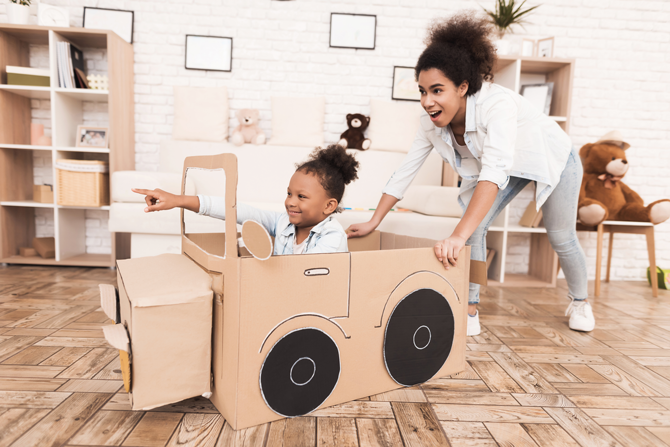
2. Cushion Forts
This activity uses problem-solving skills.
Materials: cushions, pillows, blankets
Inspire your child to build an awesome cushion fort! Give them a supply of furniture cushions, pillows, sheets, and blankets. Challenge your child to use as many of the items as they can!
3. Make a Treasure Box
This activity builds fine-motor skills.
Materials: box, old magazines, safety scissors, glue
Have your child cut out pictures from magazines and glue them to the outside of a box, such as a shoe box. Encourage your child to overlap pictures so the whole box is covered. When the glue dries, you will have a colorful work of art in which to put special trinkets!
4. Play Restaurant
This activity fosters imaginative play.
Materials: paper, crayons, play food or a few kitchen items
Have your child make a menu by drawing pictures of food and adding a price next to each one. Then gather some “meals” (you can use play food or a few small kitchen items). Your child can show you the menu, take your “order,” and bring you your meal! Encourage your child to keep the restaurant going by serving more “customers,” such as dolls and stuffed animals!
5. Salt Writing
This activity builds your child’s prewriting skills.
Materials: salt, baking tray with lip, pictures of letters, paper, marker
Fill a baking tray with salt. (You can also use sugar or flour.) On different pieces of paper, draw letters and numbers. Show your child one of the pieces of paper. Then ask them to use a finger to draw the letter or number in the salt. You can also draw different types of lines—straight lines, wavy lines, loopy lines, and zigzags—and have your child drag their finger through the salt to make the same kind of line.
6. Pasta Jewelry
This activity provides practice with patterns—the foundation of math!
Materials: tubular pasta, string or cord, markers
Let children color tubular shapes of pasta with different colored markers. Then lace them onto a string. Make different patterns. Have children tell you about the patterns they're making.
7. Drumming
This activity encourages imagination and getting feelings out.
Materials: oatmeal carton, large can or medium box, markers (optional)
Kids can decorate their “drum” with markers first or just start drumming! Tell them: Drum like an elephant walking. Drum like a lion running! Drum like you’re happy/mad/sad/surprised! Drum a pattern and challenge children to copy it. Then let them challenge you!
All images: Shutterstock.com

